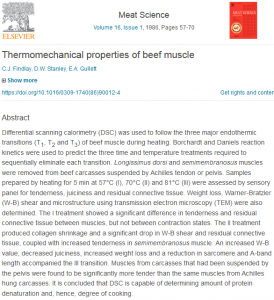Thermomechanical Properties of Beef Muscle
 Differential scanning calorimetry (DSC) was used to follow the three major endothermic transitions. (T1, T2, and T3) of beef muscle during heating. Borchardt and Daniels reaction kinetics were used to predict the three time and temperature treatments required to sequentially eliminate each transition. Longissimus dorsi and semimembraneous muscles were removed from beef carcasses suspended by Achilles tendon or pelvis.
Differential scanning calorimetry (DSC) was used to follow the three major endothermic transitions. (T1, T2, and T3) of beef muscle during heating. Borchardt and Daniels reaction kinetics were used to predict the three time and temperature treatments required to sequentially eliminate each transition. Longissimus dorsi and semimembraneous muscles were removed from beef carcasses suspended by Achilles tendon or pelvis.
Samples prepared by heating for 5 min at 57 ºC (I), 70 ºC(II) and 81 ºC(III) were assessed by sensory panel for tenderness, juiciness and residual connective tissue. Weight loss, Warner-Bratzler (W-B) shear and microstructure using transmission electron microscopy (TEM) were also determined. The I treatment showed a significant difference in tenderness and residual connective tissue between muscles, but not between contraction states.
The II treatment produced collagen shrinkage and a significant drop in W-B shear and residual connective tissue, coupled with increased tenderness in semimembraneous muscle. An increased W-B value, decreased juiciness, increased weight loss and a reduction in sarcomere and A-band length accompanied the III transition.
Muscles from carcasses that had been suspended by the pelvis were found to be significantly more tender than the same muscles from Achilles hung carcasses. It is concluded that DSC is capable of determining amount of protein denaturation and, hence, degree of cooking.
![]()
Findlay, C. J., Stanley, D. W., & Gullett, E. A. (1986). Thermomechanical properties of beef muscle. Meat Science, 16(1), 57-70. http://dx.doi.org/10.1016/0309-1740(86)90012-4